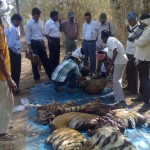The Leopard in India
A Natural History by J. C. Daniel
Natraj Publishers
The leopard today is disappearing at a fast pace either due to loss of habitat, poaching or simply due to persecution by people. The apathy shown by the authorities to incidents of lynching and burning of leopards results in these incidents continuing from different parts of the country. In such a scenario, when the leopard is perhaps in its last battle for survival, we review this remarkable compilation titled The Leopard in India : A Natural History by J. C. Daniel to make people aware about this beautiful and charismatic species.
Mr. J.C. Daniel has done a remarkable job in pouring through all the proceedings of BNHS and filtering views, opinions, anecdotes pertaining to leopards from around the country. These writings have been organised under various chapters. The initial chapter talks about the races and gives us an idea about the prevailing beliefs. The later chapters covers topics like distribution, colour, size, weight, senses, behaviour along with its interactions with its fellow denizens in the forests as well as man. These writings not only give us a glimpse of a bygone era but also help us in understanding it better.
I would be doing a disservice to the readers if I dont share atleast a few interesting tit bits gleaned from the book has been shared below.
Leopard eating a Scorpion:
A report from H S Wise published in July 1887 talks of a unique incident of a leopard eating a scorpion When walking through a jungle in the district of Canara I came upon the fresh tracks of a panther, and following these tracks a short way, I found some fresh panthers droppings, embedded in which were the remains of a large black scorpion. It was evident from the way in which the scorpions remains were embedded in the droppings that the panther had eaten and partly digested the scorpion. (page 128)
Leopard engaged in cursory predation
The leopard is a stalk and ambush predator and is not known to chase its prey like a cursory predator. It is not known to chase long distances to get its prey down. However, Mr J. C. Daniel could manage dig out one such incident reported by J. H. Coode of Nagpur when just as it was getting dark, we heard the short guttural sound of a Panther and heavy footfall of some running animal. The noises came nearer and nearer, until a Nilgai and a Panther could be distinctly seen against the skyline, the former being chased by the later. The Nilgai kept moaning, and was evidently in an abject state of fear.
The two ran round in a circle of about 160 yards diameter within 30 yards of where we were standing, and passed us twice, both of them making their respective noises. They then disappeared, but I have reason to believe the Nilgai got away. I was so interested in the sight that I did not think of firing, but it would have been an exceedingly difficult shot in the dusk. (page 128-129)
Leopard’s Mistaken charge on a man
In an interesting incident related by G. P. Millet about his encounter with a leopard in the Ghaved forest of Thane District, Maharashtra in 1894.
I went a couple of hundred yards along the ridge and then commenced to descend again through a thicket of coppice, dense enough to make progress slow and laborious. I placed my gun in the hollow of the left arm, gripping the stock from beneath and sloping the barrels outwards, whilst, with my right hand, I cleared a way as I went down the slope. I had got about half way down, and had just reached a small level bit of open grassland when, as I emerged from the thicket, I saw a panther charging straight for me. I had only time to seize the gun in my right hand and to get the thumb one on hammer in an endeavour to cock it, when the beast was at my feet. Vision of a hospital flashed across my mind and I did the only thing I could think of at the moment, which was to hit the panther over the back with the gun. From the way I was holding the gun it will be understood that the blow I was able to give was not a hard one. It was, however, sufficient to turn the panther. He slewed to my left, brushing my leg the whole length from two inches above the knee to the angle with his body, and sprang on to some rocks about five yards to the left, where he appeared to halt for a fraction of a second before springing down and bounding out of sight. As he sprang away from me I finished the cocking of the right barrel and brought up the gun to my shoulder, but the thought occurred to me that a charge of No. 8 shot in the stern at five yards could not be immediately, if at all, fatal, and might bright the panther round upon us and whilst I debated about firing, he disappeared.. About 100 yards further away from where I met him I found the flattened space where he had been lying in the grass. Why he should have charged at me deliberately in the way he did (his ears were flat to his head and he came at full speed but ventre a terre) and then have made no effort to scratch or bite me is best known to himself. My theory is that he mistook me coming quietly through the dense thicket, for a bekri: (muntjac) my shikar clothes and putties may have aided the deception. He started to charge and win an easy prey and was as flabbergasted as myself when he saw the mistake he had made.
This book with 271 pages was first published in 1996 and the second revised edition was brought out in 2009 by Natraj Publishers.
Priced at 395 rupees, this is highly recommended for naturalists, researchers, students as well as the common man with interest in wildlife. The current price in Amazon.in is Rs. 277/-
- Endangered Wild Buffalo of Kaziranga - 4 July,2024
- Leopards: The Last Stand Trailer 2 - 1 July,2024
- GoPro Hero 12 Black - 6 September,2023












